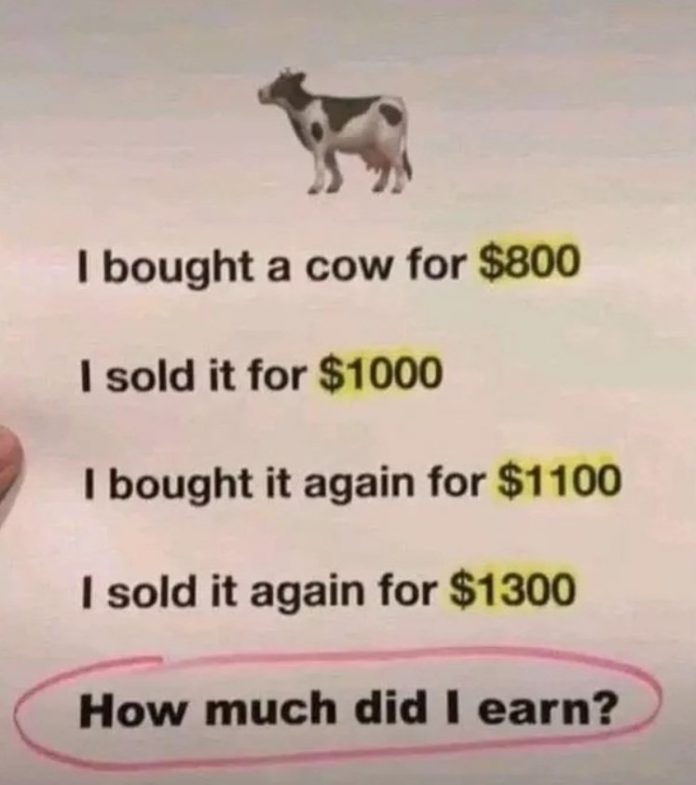A Fun and Challenging Math Puzzle to Test Your Logical Thinking
Do you love solving riddles that make you think outside the box? Are you someone who enjoys testing your mathematical and logical reasoning skills? If so, then this intriguing cow-themed math puzzle is perfect for you!
Brain teasers have always been an exciting way to challenge our minds, sharpen our problem-solving abilities, and entertain us in the process. This particular puzzle has been circulating online, puzzling and engaging many inquisitive minds. At first glance, it may seem straightforward, but once you start crunching the numbers, you’ll realize there’s more to it than meets the eye. Let’s dive in and see if we can crack this math puzzle together!
The Puzzle: Can You Solve It?
Imagine the following scenario:
- You buy a cow for $800.
- You sell the cow for $1,000, making a profit of $200.
- Some time later, you decide to buy the cow again, this time for $1,100.
- You sell it once more, but now for $1,300, earning another profit of $200.
Now comes the big question: How much money did you earn in total?
At first glance, this might seem like a simple problem, but as you think it through, you might find yourself second-guessing your calculations. Many people get confused and arrive at different answers. So, let’s break it down step by step to find the correct solution!
Step-by-Step Breakdown of the Profit Calculation
Let’s analyze each transaction carefully:
First Transaction:
- Purchase Price: $800
- Selling Price: $1,000
- Profit Earned: $1,000 – $800 = $200
Second Transaction:
- Purchase Price: $1,100
- Selling Price: $1,300
- Profit Earned: $1,300 – $1,100 = $200
By adding the profit from both transactions: $200 + $200 = $400
Thus, the total amount earned from both transactions is $400.
Why Do Some People Get Confused?
One of the reasons this puzzle trips people up is that they mistakenly try to calculate their total investment instead of focusing on the actual profits made in each transaction. Some might incorrectly assume that the total amount they handled ($800 + $1,100 = $1,900) should factor into the calculation differently. However, the key here is to focus on the difference between buying and selling prices in each instance.
Another common mistake is adding up all the money received ($1,000 + $1,300 = $2,300) and then subtracting the total spent ($800 + $1,100 = $1,900). While this method will also yield $400, it can sometimes mislead people into thinking they need a more complex formula to get the right answer.
The Fun of Math Puzzles
This cow math puzzle is a great example of how simple numbers can lead to interesting challenges. It demonstrates how financial transactions work and reinforces the importance of carefully tracking profits and losses. It also serves as a great reminder that sometimes, the way we perceive a problem can lead us astray.
Math puzzles like these are not only fun but also useful in everyday life. Whether you are calculating expenses, planning investments, or just trying to improve your logical thinking, these types of challenges help keep your brain sharp and engaged.
Conclusion: What We Learned
By solving this math puzzle, we’ve reinforced the fundamental concepts of profit calculation, logical reasoning, and attention to detail. The correct answer, as we’ve determined, is $400 in total earnings. This puzzle serves as a fun way to test your thinking skills and remind yourself of the importance of clear and structured calculations.
So, did you get the correct answer? If you enjoyed this puzzle, be sure to share it with friends and family and see if they can figure it out too! Who knows? You might just spark a fun and friendly math debate!
Happy puzzling! 🧠










